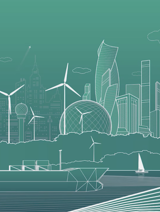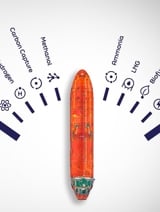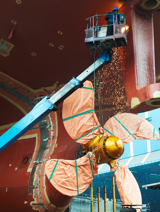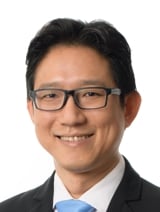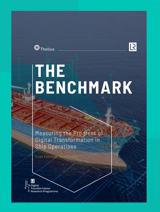You are an original equipment manufacturer (OEM). You have devised some novel technology that is not covered by existing rules or standards and you want to bring it to market. What do you do? You contact Dr Winston D’Souza, LR’s Principal Specialist in Emerging Technologies and discuss the possibility of Technology Qualification (TQ).
Aside from being LR’s expert in this field, he is also the convenor of the International Electrotechnical Commission’s (IEC) Technical Committee that published the first international technical specification that lies behind the concept. This document was published in 2020 with the reference IEC TS 62600-4:2020.
Two years later, he updated LR’s own guidance to align it with IEC TS 62600-4:2020, making it unique among TQ programmes. Now, on the back of a project that includes the world’s first ammonia to hydrogen powered vessel, Dr D’Souza wants the marine sector to embrace TQ’s potential. “This is a game changer,” he said.
It is a decade since LR first published its Guidance notes for Certification through Technology Qualification, for most of that time it had been applied to non-marine applications, especially in the offshore and renewable sectors. But its latest application – for the US-based Amogy, Inc. – has focused the attention of LR’s marine managers, Dr D’Souza told Horizons.
It all began when four MIT Ph.D. alumni got in touch with him in early 2022 to discuss decarbonisation in the heavy-duty transportation and about their Amogy ammonia-to-power concept in view of exploring whether LR’s TQ services were relevant to their plans. From the outset he saw that their proposal aligned with LR’s experience and commenced a series of discussions that led to a first technical workshop wherein the concept was analysed further. Following the conclusion of that workshop, LR issued the Amogy technology an Approval in Principle (AiP) in 2022.
Ammonia, the second most produced chemical in the world, has the highest energy density of zero carbon fuels. It is composed of one nitrogen atom and three hydrogen atoms and emits no CO2 when burned, making it a highly effective hydrogen carrier. Amogy has found a way to unlock the potential of ammonia as a fuel source through their modularised ammonia cracking power system with direct fuel cell integration for efficient generation of electricity onboard a vessel, eliminating the need to store hydrogen.
Following the initial approval, Amogy embarked upon the LR TQ process for the assessment of its technology. As the first formal deliverable from the process, in February 2024 Amogy received a feasibility statement for its Technology qualification Plan (TQP), confirming the core components of its power system have the potential of being operated in defined maritime environments. The issuance of this document concluded the Verification aspects of the technology.


Amogy is now poised to begin the Validation process in the form of component testing, as outlined in its TQP. Initially, these tests will be undertaken in controlled environments before performance tests under operational conditions. Amogy’s practical trials have showcased groundbreaking applications in converting ammonia to power. Amogy’s technology powered an airborne drone, which formed the basis of the founders’ PhD studies. The initial drone application utilised a 5kW Amogy power unit. Subsequently, Amogy scaled-up their technology deploying a 100kW Amogy’s ammonia-to-power solution on a farm tractor. As part of the TQ assessment mentioned earlier, it demonstrated a 300kW unit to power a commercial truck. Completing the entire three-stage assessment process though will require some time due to class and regulatory considerations for the maritime environment, predicted Dr D’Souza.
Currently Amogy is in the process of retrofitting a tugboat with its ammonia-to-power solution. This will be its final demonstration project before commercialisation of the technology commences. This transformative project aims to establish the world’s first ammonia-to-hydrogen powered vessel, demonstrating proof-of-concept the viability of the technology for maritime applications.
Amogy’s technology extends its relevance beyond the maritime sector to offer support in decarbonisation for power generation and stationary power applications too. Amogy has received noteworthy support from influential investors, including Aramco Ventures, Temasek, AP Ventures, MOL Plus, Amazon, and others.
More marine game-changers?
Amogy’s technology is a game-changer, because it addresses power systems that have an impact on a ship’s propulsion and other power requirements. But Dr D’Souza is not sure how often technologies of such fundamental importance will emerge from the marine sector.
He welcomes the attention Amogy has brought to TQ’s potential and said that it can also be applied to novel methodologies but was careful to manage expectations; even something as seemingly important as finding a way to improve an engine’s efficiency may not always be a sufficient game-changer for it to be assessed outside conventional certification schemes.
While the above focused on a maritime application, increasingly there has been an uptake for TQ in the renewables sector, notably the Marine Energy sector, Dr D’Souza said. Marine energy comprises of energy harnessed from Wave, Tidal and Ocean Thermal Energy Conversion (OTEC) systems.
One possible candidate is the world’s first commercial-scale floating OTEC, which has been designed by UK-based Global OTEC. In June 2023, LR awarded Global OTEC an AiP for the barge on which the technology is expected to be deployed.
OTEC technologies adopt the natural thermal gradient between warm surface and the cold deep-sea waters to produce electricity. Within a closed system, the warm surface water is used to boil off a low-boiling-point liquid, the resulting steam drives a turbine that produces electricity. The steam is then condensed back into liquid using the deeper and colder water, thus producing an endless cycle of energy production. Global OTEC hopes to position its first installation near São Tomé and Príncipe off East Africa in 2025 in delivering 1.5MW of power, replacing diesel imports with clean energy sources from the ocean.
Although the operating principle is not new, mounting it on a floating structure makes it a game-changing initiative, Dr D’Souza explained. So, while the AiP for the floating unit confirms that Global OTEC’s technology is viable, its technology will still need to be analysed in detail, “and we would initiate that through the IEC 62600-4 TQ process,” he said.
Dr D’Souza has been passionate about TQ for over a decade – even from before it became his professional responsibility – and that interest proved to be his personal game-changer. His work on the subject won him the IEC 1906 award. He is now gradually building a team within LR that will focus on developing this growing area of the class society’s work. “I saw there was something there that needed to be developed, and I thought, why not explore it further” he said.

What is Technology Qualification?
Innovation is often driven by novel designs, regulatory changes, design modifications or new applications and their introduction can be a high-risk strategy, usually outside the scope of conventional assessment processes.
LR's Certification through Technology Qualification (2022) process is a logical three-stage process for assessing the components and subcomponents of novel technologies in terms of their technology maturity and associated risks. It consists of Verification, Validation, and a Performance Review to ensure the technology can meet or exceed the technology goals for which it was designed.
This process enables a novel technology that cannot be assessed against published standards and rules to obtain assurance while being refined.
LR's Technology Qualification process can be applied at any stage of the technology’s development, though there are distinct advantages to early engagement with the process. As a systematic evidence-based process for managing technology-related risks, it provides confidence to all stakeholders that the technology can achieve its objectives with an acceptable level of confidence.

Technology Qualification vs Risk Based Certification
In its very first paragraph, LR’s Guidance notes for Certification through Technology Qualification links innovative designs or concepts to risk, which it says, “Innovation and new technologies … can introduce risks and challenge project outcomes.”
But it is not the only LR document that addresses risk. In 2021, the class society published a 20-page document about risk-based certification (RBC) that applies to – among other things – “designs that are considered new or novel”. That publication took account of three IMO circulars, each of which provide guidelines on various aspects of alternative design approaches. So, what does TQ offer that RBC lacks?
Dr Winston D’Souza, LR’s Principal Specialist for Emerging Technologies, set out an important distinction between the two: RBC forms part of a class certification process, so it considers risks arising from introducing a novel technology into a class environment. TQ, on the other hand, looks at technology in a wider context, and not just in terms of risk. It evaluates the quality of integration between various systems and subsystems that underpins a technology in terms of safety, efficiency, reliability, availability, survivability, operating and environmental conditions, etc.
As a result, the two certification methods are relevant to two different communities: RBC focuses on ship owners and operators, while TQ is relevant to OEMs. When viewed in that context, “TQ precedes RBC in many ways,” Dr D’Souza said.

